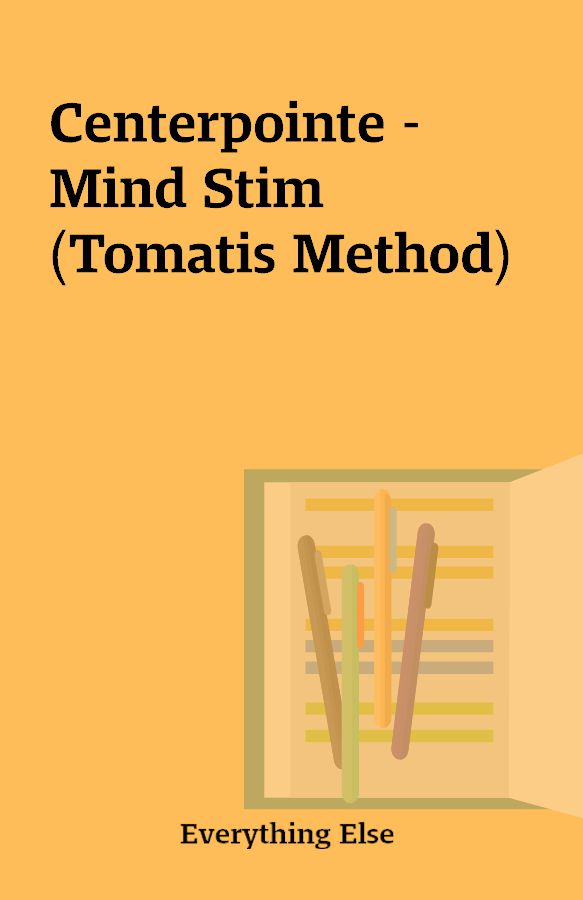Centerpointe – Mind Stim (Tomatis Method)
Centerpointe – Mind Stim (Tomatis Method) [FLAC]
[1 CD – 1 FLAC]
Description
PLEASE KEEP THIS EXCLUSIVE!!!SHARING THIS MATERIAL ELSEWHEREWILL GET YOU BANNED Centerpointe – Mind Stimhttp://www.centerpointe.comhttp://www.meditate.com.au/tomatiscd/Alan HewittEarth Star Publishing (Australia)Sales pitch: Quote:”An Open Letter to Sincere Individuals InSearch of an Affordable and EffectiveSolution for ADD, ADHD, autism, dyslexia,Down syndrome, epilepsy, vertigo,tinnitus, insomnia or a wide rangeof learning disabilities — WITHOUTThe Common Headaches of MostPrograms, Including Drugs, ExpensiveClinic Visits or Special Equipment”This letter reveals how you can enjoy exceptionalresults quickly and easily in the comfort ofyour own home…If you or your family would like help with dyslexia, ADD, ADHD, autism, vertigo, tinnitus, insomnia, Down syndrome, epilepsy or a wide range of learning disabilities then this might be the most important letter you’ll ever read.Here is a summary of the areas Tomatis-based therapy can help:Dyslexia and DyspraxiaAttention Deficit Disorders (ADD)Attention Deficit Hyperactivity Disorders (ADHD)AutismSpeech and Communication ProblemsVertigo, Balance and Coordination ProblemsSensory integration and motor skill difficultiesTinnitusInsomnia and Sleep ProblemsAsperger’s SyndromeDown SyndromePervasive Development Disorder (PDD)Epilepsy—Now, you’re probably wondering how and why it can help all those areas.Let me explain…Sound therapy (also known as listening therapy or neuro-development therapy) is a science which has been researched and developed over the past fifty years. It’s for those with auditory processing problems and is different from music therapy, or any treatments for hearing problems. It is particularly relevant to those children and adults whose language difficulties are linked to auditory processing problems.Sound therapy is based in the sciences of neurology, physiology, psychology, acoustics, and music. Sound therapy began with Alfred Tomatis, MD, a French ear, nose and throat specialist. After years of research into the function of the ear, and studying the role of the ear in processing sound, its effect on the brain, and neurological system, from the womb into old age, Dr. Tomatis developed a system of auditory training know as the Tomatis Method.Dr. Tomatis noticed that his patients experienced unanticipated psychological, behavioral and physiological benefits when exposed to music with heavy concentration of high frequency sound vibrations. Their muscles relaxed dramatically; they felt energized; attention, concentration and memory faculties improved; cochlea-vestibular and psychomotor responses improved; and many types of learning problems were dramatically lessened.In thousands of case studies, Dr. Tomatis determined that those who could benefit from high-frequency sound therapy all had a common problem; regardless of their other presenting symptoms, they had a listening disorder. Symptoms of a listening disorder include: Short attention span/poor memory Singing off key Over sensitivity to certain sounds Easily distracted/frequently daydreaming Broken or hesitant pace of speech Weak or flat (monotone) voice Disorganized syntax/sentence structure Left-right confusion Letter/number reversals Low energy/poor motivation Excess energy with restlessness Misinterpreting requests Needing repeated or simplified directions Delayed language/weak vocabulary Over talkative but says little Reading/spelling/writing problems Poor “slumped’ posture Awkward coordination/accident prone Poor sense of balance or rhythm Problems mastering mathematics Low self confidence/self assertion Short frustration tolerance/immaturityAccording to Dr. Tomatis, a listening disorder, which is not the result of an immature inner ear or damaged sensori-neural system, can have a psychological origin (as a result of emotional trauma, illness, accident, etc.)Therapy based on the work of Dr Tomatis uses sound to re-educate the ear to the natural state of proper listening that is a basic function of the human body.Here’s why this type of therapy works in general…Sound waves are known to affect the body differently depending on their frequency. Low frequency vibrations affect the body and vestibular function; sounds that cannot even be heard, can be felt. Mid-range frequency vibrations are those of speech and communication, while high-frequency vibrations energize and affect mental and psychological operations.During the therapy, the sound stimulates the sensori-neural pathways from the ear to the brain stem to the brain.From a neuropsychological viewpoint, Dr. Tomatis thought that this stimulation works to correct immature or incorrectly wired sensori-neural connections. Attention, speed of information processing and reaction time are directly affected.And here’s more about Tomatis and some specific conditions…DYSLEXIA: Dr Tomatis contended that people with dyslexia (both children and adults) have failed to achieve right ear dominance and that therefore the order in which they hear sounds becomes jumbled. If they sometimes use the left and sometimes the right ear as the directing ear, sounds may reach the brain at different speeds, so letters will be jumbled.The balance between the two hemispheres of the brain is of fundamental importance in overcoming dyslexia. Both hemispheres play a role in processing language, but the roles they play are different. The eye must combine with the power and the quality of the ear to make sense of the written sounds.In dyslexia, the route which allows for phonic analysis has been damaged. Mind Stim may help restore the functioning of this route and eliminates the cause of the problem by stimulating and exercising the ear, encouraging it to receive and interpret sound in an efficient manner.ADD/ADHD: The majority of people with ADD/ADHD (both children and adults) have auditory reception problems. Although they can hear, they have difficulty making sense of what they hear. They cannot tune out unwanted input and focus on selected sounds. It is this indiscriminate reception of auditory input which leads to the inability to concentrate their attention on a selected topic for any length of time. Poor functioning of the frontal lobe means the person cannot think quickly enough to put the brakes on and control the impulse to act. This impulsiveness and hyperactivity also leads to behavioral problems and poor social skills.By stimulating the frontal lobe, Mind Stim may restore the person’s ability to think quickly and put the brakes on before acting. It may also retrain the listening capacity or the auditory reception process, so that the person may learn to focus on the desired sound and to relay the sound directly to the language canter in the brain. Auditory reception problems are caused by the shutting down of the ear to certain frequencies of sound. The ear muscles become lazy and unresponsive and must be stimulated in order to regain the capacity to tune into the desired sound.Mind Stim may be able to provide this rehabilitation for the ear and re-organize the auditory transmission in the brain in some cases. This process reduces stress and tension in the whole nervous system as the person becomes able to attend to a chosen stimulus instead of being constantly distracted by every sound in the environment.AUTISM: Many people with autism (both children and adults) exhibit extreme sensitivity to noise. Some frequencies are actually painful for them to hear. Dr Tomatis suggested that in order to shut out painful sounds or other unwanted stimuli the person closes down the hearing mechanism so that certain sounds cannot penetrate the consciousness. On a physiological level, this closing off of the ear is achieved by a relaxation of the muscles of the middle ear. Over time, these muscles lose their tonicity.Sounds are then imprecisely perceived and as a result, incorrectly analyzed. Tomatis believed that the reluctance to communicate in people with autism results from the closing off of their being to auditory input. Although they may understand what is said to them, they have tuned out many of the frequencies in the sound and have thus tuned out the emotional content of the message.Mind Stim may offer a person with autism the opportunity to re-open the listening capacity. The fluctuating sounds gradually exercise and tone the ear muscles, teaching the ear to respond to and recognize the full range of frequencies. As this happens, communication takes on new meanings, and the person begins to respond where before he or she was unreachable.SPEECH AND COMMUNICATION PROBLEMS: Unless there is a deformity in the vocal apparatus, most speech difficulties are caused by some interference or distortion in auditory reception. Although the hearing may test as normal the relaying of verbal information to the brain may be impaired. Hearing our own voice is a source of constant feedback while we are speaking and if there is any confusion in the sequence of received sounds, it will cause confusion in the output of speech. The results can be substitutions of one sound for another, stumbling over words or a flat and toneless voice.Most people use the left hemisphere of the brain as the primary integrating canter for language. Some studies have shown that stutterers process language primarily in the right hemisphere or a mixture of the two. The right hemisphere is less efficient for processing auditory information, so the result is problems in the timing of speech output.Speech difficulties frequently lead to problems in other areas where language is used, such as reading and writing. The element which is the basis for all these skills is the ability to hear and process sound accurately.Dr Tomatis made an important discovery about the relatedness of the ear to the voice. He established that the larynx emits only those harmonics that the ear hears. A lack of tone in the voice indicates a lack of tone in the hearing. Mind Stim may fine tune the hearing and restores the ability to hear missing frequencies, by exercising the ear muscles and stimulating the receptor cells in the inner ear.VERTIGO: Dr Tomatis proposed that some forms of vertigo which produces attacks of dizziness is also due to an anomaly in the tension of the stirrup muscle. This muscle may be subject to involuntary twitches, like any other muscle in the body. Such twitching would radically alter the fluid pressure in the inner ear chambers, thus causing havoc with the balance mechanism. The re-toning of the stirrup muscle achieved by Mind Stim has been known to resolve this condition.TINNITUS: There are various theories about what produces the experience of tinnitus. Some of the most accepted ones include damage to the sensory cells in the inner ear, congestion or imbalance of fluid in the inner ear chambers and hyperactive brain cells.The middle ear contains two tiny muscles, which play an active role in the functioning of the ear. Dr Tomatis believed that lack of tone in these muscles means that the ear loses its ability to recognize certain frequencies of sound, so these sounds never reach the inner ear. The ear’s ability to adjust and balance the fluid pressure in the inner chambers is also impeded if the stapedius muscle is not fully functional.Mind Stim challenges the ear with constantly alternating sounds of high and low tone so the ear is re-introduced to high frequencies possibly improving the tone and responsiveness of the middle ear muscles.Dr Tomatis said that once the ear opens to high frequency sounds, the sensory cells in the inner ear can be stimulated and restored to their upright, receptive position. This helps to rehabilitate the ear, resulting in the reduction or stopping of the tinnitus in many cases.Not every case of tinnitus can be relieved, but numerous listeners have reported that Mind Stim stopped or relieved their tinnitus where nothing else would work.The length of time it takes to achieve results varies from twenty four hours to fourteen months. Usually more severe cases take longer, so it is advisable to persist with listening for at least six months.INSOMNIA AND SLEEP PROBLEMS: Mind Stim encourages re-education of the ear to receive very high frequency sounds, between 8,000 and 16,000 Hz. Most of us have closed off to some extent to these sounds because of stress and long term exposure to damaging, low frequency noise from machines.As the middle ear muscles are rehabilitated by Mind Stim, high frequencies can once again reach the inner ear. The high sounds aim to stimulate the brain and improve the functioning of the whole nervous system. Stress reduction enhances the body’s ability to replenish itself with sleep. Through gaining deeper sleep, many listeners find that they need less sleep and can reduce their requirements by two or three hours per night.Insomnia is caused by excessive cortical excitation that cannot be stopped. Mind Stim aims to re-charge the brain for activity during the day, it may have a calming effect which enables the listener to slip easily and quickly into sleep. While the brain and the nervous system are stimulated by the sound, an active serenity may be experienced, which also allows for deep rest. Sleeplessness due to anxiety may also be resolved.DOWN SYNDROME: Seventy five percent of people with Down Syndrome (both children and adults) have a hearing impairment. This is most often due to recurrent middle ear infections and wax impaction. Repeated chronic middle ear infections result in fibrous adhesions which limit the movement of the ossicles resulting in progressive hearing loss. People with Down Syndrome are significantly affected by sensory deprivation and they need preventative measures if they are to reach their full cognitive potential. A delay in the comprehension of language results in a delay in speaking.The impairment of language abilities delays learning in all areas and makes the task of education and socialization more difficult. This results in behavior problems which could be avoided if the language abilities were improved.It is very important for children with Down Syndrome to have their hearing treated in the early years to assist with language development. The greatest area of difficulty in learning is in auditory vocal processing. They often have difficulty learning to manipulate the speech system, coordinating the tongue, lips, jaw and palate. Because they face much greater obstacles in producing speech sounds they need assistance with their hearing more than ever.Dr Tomatis discovered that the voice can only produce what the ear hears. Mind Stim stimulates the hearing capacity and exercises the ear, training it in particular to receive high frequency sounds that are lost when hearing is damaged. The sounds of consonants, such as b, d, p, g and t are high frequency sounds and are of course essential for clear comprehension of speech. Before they can begin learning to produce these sounds, children must first be able to hear them. As Mind Stim may restore hearing in the full range of frequencies, a greater range of tonality is available to the voice and this is very important for producing intelligible speech.EPILEPSY: The function of the ear is not limited to just hearing. It could even be said that hearing comes after what are more important functions of the ears. First of all the main function of the ear is to give tremendous energy to the brain, secondly the ears control the posture and induce a good verticality so that the person not only hears but listens properly.Mind Stim works on a physiological level as well as an emotional level, but, of course, the two interact very deeply. On the physiological level, the treatment balances the response of the two ears and therefore balances the level of energy getting in the two hemispheres. On the emotional level, the sessions have a very deep relaxing effect and release lots of anxiety. This feeling of well-being is very important as in many cases the fits seem to be stress related, as if the convulsion was the only way the person could find to cope with an emotional situation.After using Mind Stim it is common to observe a change of pattern: the fits become less violent, less frequent and the person recuperates much faster.All this is backed up by scientific research. For example:STUDY: Stutt, H.A. (1983), The Tomatis method: A review of current research. Montreal: Mc Gill UniversityREPORTED RESULTS: the Tomatis Method produces benefits beyond what could be expected by maturation or remedial education alone. The benefits mentioned by Stutt include:A significant increase in I.Q.Better reading skillsMore perceptual processingIncreased academic skillsA general sense of adjustmentMore developed communication skillsA greater ability to verbally express thoughts and feelingsSTUDY: Gilmor, T.M. (1999), The Efficacy of the Tomatis method for Children with Learning and Communication Disorders, International Journal of Listening.REPORTED RESULTS: On average, 231 underachieving or learning disabled children saw significant improvements in linguistic skills, psychomotor skills, personal and social adjustment skills, cognitive skills and auditory skills.STUDY: Dr. Joan Neysmith-Roy from the Department of Psychology in Regina conducted a careful study with six severely autistic boys and use of the Tomatis effect.REPORTED RESULTS: Three (50%) of the boys demonstrated positive behavior changes by the end of the treatment. One boy was no longer considered autistic; two boys showed mild symptoms of autism and three boys remained within the severely autistic range. Of particular interest were the changes that occurred in the pre-linguistic areas of five of the six boys. These included “adaptation to change”, “listening response”, “non-verbal Communication, Emotional Response and Activity Level.STUDY: The Tomatis Center in Toronto, Canada studied 400 children and teenagers with various learning disorders who used the Tomatis Method.REPORTED RESULTS: Their parents reported improvements in the following areas by the percentage amounts indicated:Greater Communication Abilities (89%)Better Attention Span (86%)Frustration Level Decreased (80%)Reading Comprehension Increased (85%)Quality of Speech Improved (74%)Memory Improved (73%)Better Spelling Aptitude (69%)Showed more maturity (84%)In addition, in a follow-up six months after the program, 83% of those children in the study had maintained the improvements and/or had continued to make even further gains. An additional 14% of the children had maintained some of the gains. Only 3% had maintained none of the improvements.There are 200 Tomatis centers throughout the world, where many dyslexic children/adults, other learning disabled children, musicians, singers, and people from all walks of life have benefited greatly from the sound therapy treatment.Introducing Mind Stim…And although sound therapy has proven to be very beneficial, the time and cost of the Tomatis Method has been prohibitive for many. Fortunately, the highly effective yet affordable Mind Stim program, which is based on an extension and expansion of the work of Dr Tomatis, is now available.Here’s how the Mind Stim program works:Two tones in each ear are simultaneously sweeping up, then down. The first tone is sweeping from extremely low subsonic frequencies, around 20 cycles per second, up to 100 cycles per second. At the same time, the second tone is sweeping up from an extremely high ultra-sonic frequency of 8,000 cycles per second up to over 19,000 cycles per second. Each sweep up is followed by a similar sweep down.The same thing is happening simultaneously in each ear. Each sweep cycle (up and down) takes 0.2 seconds, so there are five up and down cycles per second. This causes the inner ear muscles to expand and contract over and over very quickly thus providing the “Tomatis effect”.Here’s what researcher Michael Hutchison says in his book Mega Brain Power about the Silent Stim process used on Mind Stim:”Perhaps the most important breakthrough in the delivery of high sound therapy frequencies is a newly patented Silent Stim process. Recent tests have shown that it can produce sound therapy tapes and CDs that are over 75 decibels stronger in the high-frequency ranges (which translate mathematically to about 12 million times more powerful) than other sound therapy cassettes.”The process gains much of its power by sweeping (frequency modulating) the high-frequency end of the audio program. It also sweeps the low-frequency end. Both ends are then swept in rhythmic alternations, forcing the ear muscles to exercise by expanding and contracting between the high and low-frequency sound groupings. Since these sounds are partially outside the normal human hearing range, they can be played on tapes or CDs 100 percent of the time as ‘silent’ background to music or other sounds. They can thus have profound brain-stimulating effects without even being audible.”How to use Mind Stim:Mind Stim is available in audio CD format only and can be listened to with headphones or over speakers, even in your car. There are water sounds covering the sweeping frequencies so you can even play it in the background while you watch television or do other things.You can listen to Mind Stim as much and as often as you like. It’s particularly effective when played softly in the background overnight while sleeping. We’d recommend a minimum usage of 30 minutes per day for two to six months.—About Mind StimQuote:Mind Stim works best with stereo headphones, but you may also listen over speakers, even in your car. You can even play it in the background while you watch television or do other things. You can listen to this soundtrack as much and as often as you like. Some of the effects that the program is said to bring out (as stated inside the cd cover) are: – Heightened creativity and mental capacity. Improved memory, concentration and learning ability. Enhanced mental stamina. – Easier, more efficent sleep. Sleeping time shortened by up to 3 hours a night. – New vitality and sense of well being. – Obliteration of tiredness and fatigue. – Deep relaxation and relief of anxiety, with consequent healing of stress-related disorders such as high blood pressure, hypertension, digestive problems. – Helps with dyslexia, hyperactivity, ADD, and behavior problems in children. – Weight loss.The theoritical side Mind Stim is based ofhttp://en.wikipedia.org/wiki/Alfred_TomatisThe Technology behind Centerpointehttp://en.wikipedia.org/wiki/Binaural_beatsWeb siteshttp://www.centerpointe.comhttp://www.meditate.com.au/tomatiscd/
You must be logged in to post a review.






Reviews
There are no reviews yet.